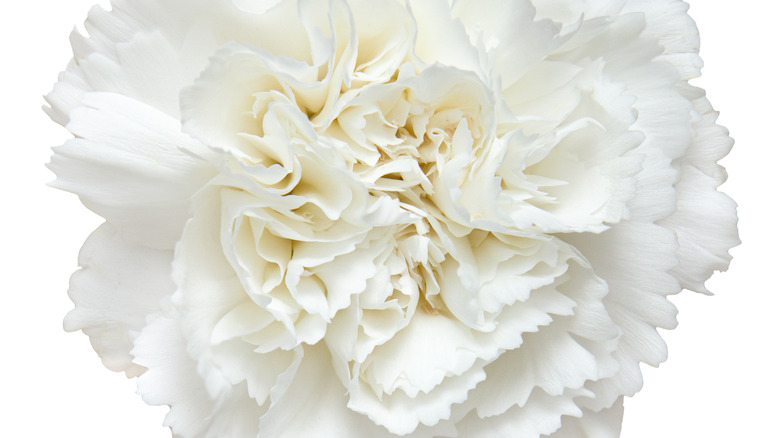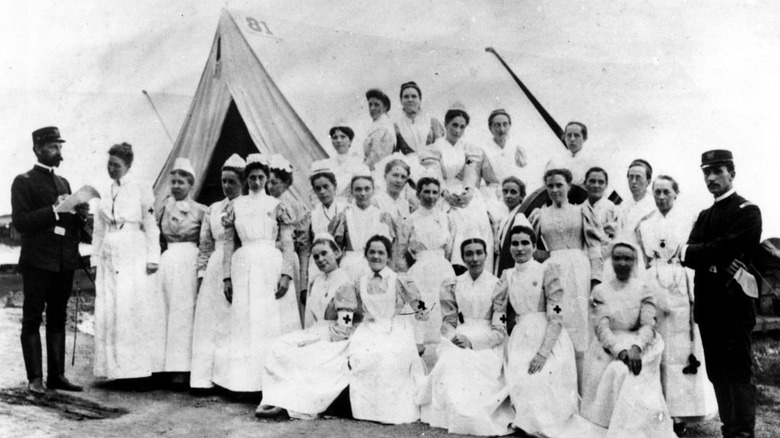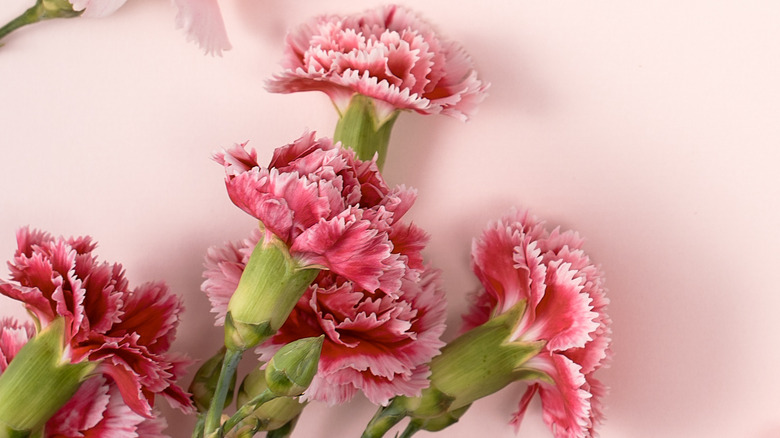The Real Reason White Carnations Are The Official Flowers Of Mother's Day
Mother's Day. That day you remember last minute before buying a $2.50 card for the lady who gave you birth. Actually, how much are cards these days? We have no clue, because we've long-since resorted to those sad email gif-cards combined with a pack of bath salts delivered directly to mom's house from Amazon in an atrociously oversized cardboard box. Thanks, mom, for making me alive.
But really, Mother's Day is a day for all of us because we've all been born. But even though we've all — plural — been born, have a look at the name of the day again: "Mother's," in the singular possessive. One mother to one child bound by a personal relationship that can't be replicated, no matter how universal it is. This is certainly what Anna Jarvis felt, and she's the lady who created Mother's Day. Yes, no matter how Mother's Day has been co-opted by annual and perennial merchandizing, the holiday was envisioned and lobbied by one person. And Anna Jarvis' mother, Ann Reeves Jarvis? As Here by Design says, she's the one who preferred modern Mother's Day's official flower, the white carnation.
When Ann Reeves Jarvis, a volunteer nurse during the U.S. Civil War (1861-1865) and overall irreproachably kind-hearted person, passed away in 1905, her daughter Anna set out on a mission: Make a day to honor mothers and their love and hardships in a personal sense. Anna's particular memento mori for her mom's funeral? Five hundred white carnations.
Volunteer caregivers in the mid-1800s
So we all know the mid-1800s in the United States were not an easy time, right? We're talking the era of the Oregon Trail (1841-1869, via Legends of America), the Mexican-American War (1846-1848, via History), settlers incessantly gunning it out with indigenous peoples (detailed on Legends of America), and of course, the U.S. Civil War that left over 600,000 people dead (via History). The lesson here? Do think twice before whining about paltry things, please.
Mothers, as always, provided societal glue during that entire period. They watched their babies die in infancy to measles, typhoid, diphtheria, and other common diseases. They watched their grown babies die in war. And even at the same time as when the original modern nurse in England, Florence Nightingale, was transforming nursing into a respected profession, tending to the war-torn and sick (described on BBVA), folks in the U.S. were doing the same.
Ann Reeves Jarvis was one of those contentious individuals, who herself lost eight infants to disease (via Here by Design). Her remaining four children survived and grew up to witness their mother not only take care of them, but join Mothers Day Work Clubs and take care of other people, too. These volunteer organizations cared for the sick, raised funds for medicine, engaged in food and milk inspections, and more. When Jarvis died, her daughter Anna wanted to do something to show her gratitude and respect.
The inauguration of a national holiday
Anna Jarvis passed out 500 white carnations at her mother's funeral at their home church in Grafton, West Virginia, in 1905 (via Here by Design). This, she felt, constituted the beginnings of a proper tribute. Rather than stop there, however, she lobbied politicians at all levels of government until, nine years later, in 1914, President Woodrow Wilson passed Proclamation 1268. The second Sunday in May would be a "public expression of our love and reverence for the mothers of our country," i.e., Mother's Day. The tradition of giving white carnations carried on as well.
At present, white carnations on Mother's Day have expanded to differently colored carnations and all sorts of other flowers, each with its own symbolic meaning. Pink carnations represent appreciation, for instance, and light red represents friendship (via Petal Republic). But of course, any flower can mean whatever you want. That's the whole point of Mother's Day — it's between you and your mom.
Speaking of which, Anna Jarvis had a lot to say about the sweeping commercialization of Mother's Day, come 1920. She deeply resented generic, mass-produced cards and corporate commandeering of a personal gesture, to the extent where she actually pushed to abolish the very holiday she created. Money being what it is, we suppose, she unsuccessfully lobbied to abolish Mother's Day until her death in 1948. But corporate or not, we're sure your mother wouldn't mind a little token of thanks come the second Sunday in May.


